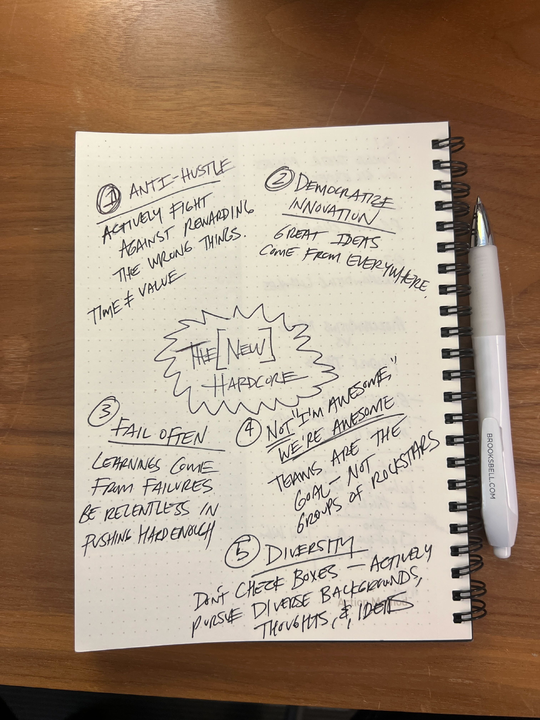
When Elon Musk took the reins at Twitter, he gave engineers an ultimatum: Be extremely hardcore or get out. From his perspective, righting Twitter’s ship required working long, intense hours. In other words, Musk believes time in the trenches translates to great performance.
I disagree.
If you’ve followed me for even a short period of time, you’ll know this “all-in” approach goes against everything I believe in. Expectations like Elon’s perpetuate dated, unwritten hierarchy rules, positioning employees as indentured servants to executives. It also equates time spent in the office to commitment, which, as I wrote about here, is just plain wrong.
Soon after Musk’s memo, a photo of him holding court in Twitter’s office at 1 a.m. went viral. Sure, business realities require odd hours from time to time. And of course, we’d hope CEOs weather the occasional storm alongside their team. But as one Washington Post column put it, “Twitter is not a scrappy start-up operating out of someone’s mom’s garage with three employees and a minifridge of Red Bull. It is a well-established, 16-year-old tech company.”
It’s not part of a leader’s job description to ask employees to put the rest of their lives on hold, stir up anxiety or make threats. No company needs a Chief Fear Monger. In my experience, strong leaders are the exact opposite, guiding their team by creating a safe, supportive environment and inspiring action through clear, reasonable expectations.
Redefining hardcore
Elon’s not alone in his “hardcore” expectation. The Musks, Bezoses and Jobses of history created dangerous corporate fairytales. As their intense leadership styles gained traction, young employees began to see unfair demands as a necessary evil while investors started to see “hardcore” as a valuation point.
But many of these executives built companies simply to make a splash. What if instead, leaders built mission-driven companies that prioritize their people? One such business leader here in Durham, North Carolina, comes to mind. Even though he’s not a household name, Jim Goodnight, founder of Sas, caught the attention of Google’s founders when they started out. They had heard about Sas’ culture driven by curiosity, innovation and authenticity, which led many employees to remain at the company for years.
To me, Jim Goodnight’s version is a healthier“hardcore” — constantly pushing for better. Not in profit or growth, but to be an all-around better company. This approach doesn’t require ultimatums or forcing people to stay at the office after hours. Leaders that encourage employees to buy into their mission and show up as their full selves don’t need performative late-night meetings. They know this level of commitment is what moves the needle. Leaders can build these dedicated teams by practicing a new hardcore. Here’s how:
1. Champion the anti-hustle
It’s not good enough to just reject hustle culture. You need to actively fight against it. Even at organizations that set up boundaries for balance, people still work late, work weekends and don’t take advantage of benefits.
Leaders can’t just say they’re against unhealthy work habits. They need to help teams fight the urge to undo positive guardrails every day. This could mean reminding team members to avoid after-hour pings — it’s not just unfair to them, it’s unfair to others. You can also include relationship-building opportunities in team meetings. Time together should be as much about connecting as it is about broadcasting information.
Employees appreciate policies that encourage deeper connections and work-life balance, but for these changes to actually take hold, executives need to lead by example.
2. Democratize innovation
Most leaders’ personalities inevitably shape the organization’s vision, but this can be a trap. As the CEO, I may steer the boat, but I rely on others to help paddle it downstream. Organizations that hinge on just one person are dangerous — it takes a chorus of ideas to succeed.
Innovative ideas can come from anywhere, you just need to make room for them. Think back to your first ever job. For me, I was 16 years old, working at McDonalds. Although I came up with lots of ways to improve the operation, without the opportunity to share them, the only person who heard my ideas was the kid next to me at the register.
It’s not easy to capture every idea that emerges from your team. You have to be intentional and solicit them, which is what makes this a hardcore initiative. Not everyone feels comfortable volunteering, so you can’t just wait for people to bring you fully formed ideas. You need to engage people often — and know when to shut up. I try to invite ideas and perspectives through recurring, agenda-free meetings with individuals or groups. Great ideas are out there — we just need to make room for them.
3. Fail often
Status-quo corporate processes have a way of thwarting innovation. If you can’t test new initiatives hard and fast, you’re just wasting time. When an idea fits your vision, you need a stable environment that enables you to test its legitimacy before you put too many resources behind it. Otherwise, you’re only incrementally improving with one-offs. To be hardcore, you need to constantly pursue innovation.
At Brooks Bell, we’re devising a standard cycle that efficiently tests ideas with little risk. Our goal is to create a path that we can fly down, bringing new ideas, for our clients and our own business, into practice with greater confidence and speed.
4. Establish “we’re great”
In Tribal Leadership, Dave Logan, Halee Fischer-Wright, and John King discuss the five stages to assess, identify and upgrade organizational culture. I think about the fourth stage often: “We’re great,” or tribal pride. It’s the belief that individuals cannot personally succeed unless the collective succeeds.
It’s easy to stop at the previous stage, i.e., “I’m great,” and reward star performers. But a group of lone rock stars is a culture reminiscent of the Hunger Games. Everyone competes with each other, taking accountability only for what’s specifically assigned to them. However, accountability naturally occurs in cultures that reward the group. When employees feel like they’re part of a larger movement, they’re motivated to become better versions of themselves.
At Brooks Bell, we establish tribal pride by creating well-rounded metrics for evaluation. It’s not just about how many wins you have, it’s also about your ability to function as a team player. We also award bonuses as a percentage based on business outcomes, not as individual handouts. If you say your company “is in it together,” your policies should reflect that. When they don’t, employees notice.
5. Pursue real diversity
Diverse ideas come from a diverse team. Too often, organizations view diversity as a quota to fill. But it’s not good enough to tout an executive team that represents a number of generations, races and gender identities. That’s not diversity, it’s demographics.
Diversity is a commitment to not just include, but celebrate different backgrounds, schools of thought and perspectives. It’s the relationship between the ideas your team brings forth and your willingness to hear them.
The new hardcore relentlessly pursues diversity, going beyond table stakes policies like granting cultural holidays and adjusting language. As leaders, we can create a safe space for diversity of thought through willingness to discuss anything, even criticism. We can embrace diversity by not just welcoming new perspectives, but by responding with “tell me more.”
Growth is not everything
Listening to the Elons of the world, you’d think success requires unhealthy demands. But by re-evaluating success and how you get there, we can start unraveling these hustle-glorifying myths. The quest for growth itself is what enables these oligarchs. And its flashiness doesn’t necessarily lead to success, as Musk sees resignations and potential legal battles.
We all enable these toxic leadership styles when we revere riches over progress and people. As we enter a new year, let’s shift how we measure success, championing those who make good companies over those who make good headlines. I’d argue the latter is a fast track to mayhem for employees, customers and stockholders. If each of us strives to be the Jim Goodnights of our industries, we can make “the new hardcore” take hold — embracing a people-first culture that dethrones bad leadership once and for all.
